Kṛttikā—The Beckoning Fire

अ॒ग्निर्नः॑ पातु॒ कृत्ति॑काः। नक्ष॑त्रं दे॒वमि॑न्द्रि॒यम्।
इ॒दमा॑सां विचक्ष॒णम्। ह॒विरा॒सं जु॑होतन।
यस्य॒ भान्ति॑ र॒श्मयो॒ यस्य॑ के॒तवः॑। यस्ये॒मा विश्वा॒ भुव॑नानि॒ सर्वा̍।
स कृत्ति॑काभिर॒भिसं॒वसा॑नः। अ॒ग्निर्नो॑ दे॒वस्सु॑वि॒ते द॑धातु ॥ १॥
agnir naḥ pātu kṛttikāḥ |
nakṣatraṃ devam indriyam |
idam āsāṃ vicakṣaṇam |
havir āsaṃ juhotana |
yasya bhānti raśmayo yasya ketavaḥ |
yasyemā viśvā bhuvanāni sarvā |
sa kṛttikābhir abhisaṃvasānaḥ |
agnir no devas suvite dadhātu || 1 ||
“Agni should protect us (as) Kṛttikā (stars);
The divine Nakṣatra (as if) belonging to Indra,
And their (stars) this radiant vision.
You should offer the offering to the Fire,
Whose rays shine, whose flames (shine)!
To whom all these worlds belong,
He is imbedded in the constellation Kṛttikā”
And Then There Were Six

In the heavenly tapestry, from Aries 26°40’ to Taurus 10°, lies the palace of Kṛttikā. The lunar mansion of Kṛttikā is tenanted by a group of star clusters popularly known as the Pleiades in Western astronomy. The magnitude (brightness) of this asterism is 2.84. While a lone star of this size would not be dazzlingly bright, a cluster of the stars—when placed against the backdrop of a dark cosmic road—is an unmistakable presence. As a result, its “inhabitants” have been the subject of dozens of myths across the continents.
Though often described as Seven Sisters, in reality, Kṛttikā is a large cluster of stars of which six are very bright and form a pattern that has the likeness of an old-fashioned razor or a cleaver. The Pleiades (derived from Greek) were the seven daughters of Atlas put in that asterism by their father to protect them from the pursuit of Orion. One of the seven is said to be hiding, so we only see the six bright stars in the cluster. Other tales speak of the seventh, the “Lost Pleiad” as losing her status because she married a mortal. There are echoes of these stories in the Vedic tradition, wherein Kṛttikā is the abode of six banished wives of the great Sapta (seven) ṛṣis (sages). The seventh wife was allowed to remain close by her husband in the magnificent Saptaṛṣi constellation we know in the West as the Big Dipper.
Welcome the Master of Ceremonies
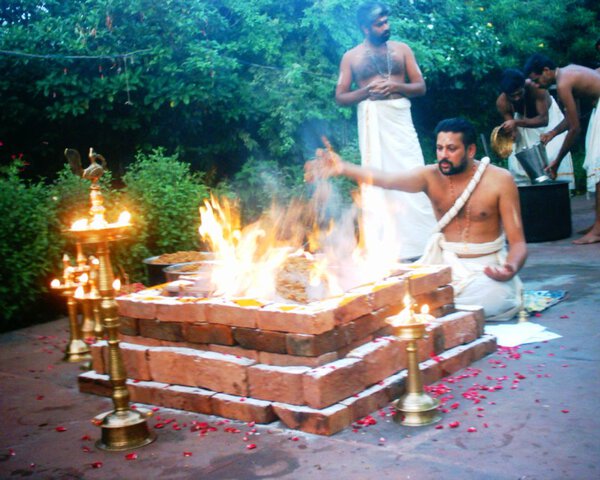
The presiding deity of Kṛttikā is the fire god, Agni. In Vedic fire rituals (homas), Agni is invoked as the intermediary between the mundane and the heavenly realm as he is the mouth of the gods and conveys offerings to them in the homa. The ancients believed that for a prayer to be answered, offerings and oblations must be made to the gods. As a medium between the physical and the spirit world, the devotee’s prayers and praises are facilitated by Agni in hopes that the magnitude of their faith and devotion will be answered in kind. Though there are other forms of prayer and ritual, it is the fire ritual that is most dramatic and elaborate.
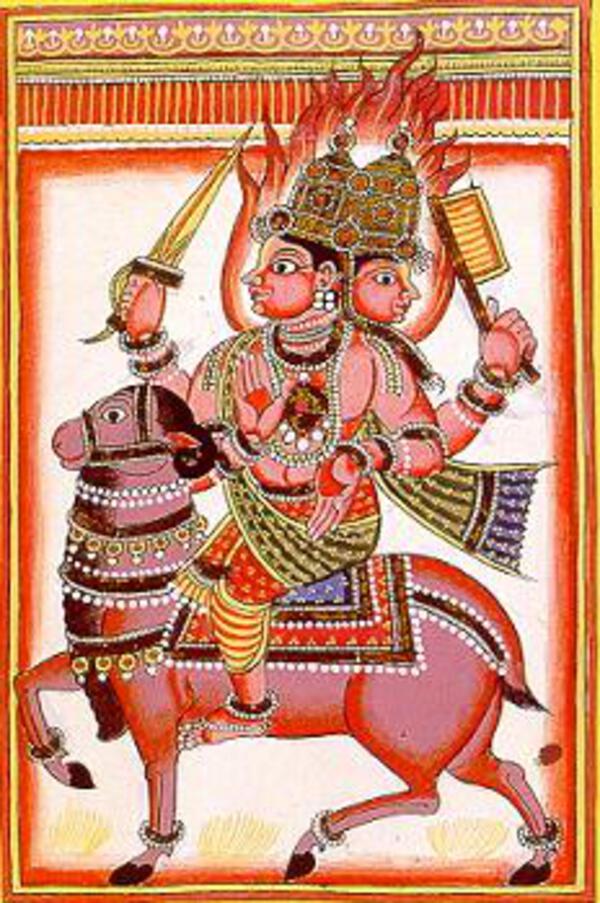
Hundreds of hymns are dedicated to this central deity. In fact, the very first verse in the oldest of the Vedas, the Ṛg Veda, begins with the word “Agni.” In the Vedic tradition, Kṛttikā was considered to be the first nakṣatra rather than Aśvinī, as Agni is the sacred fire around which all the other nakṣatra deities will be invited to gather[1]. Agni is the initiator, the messenger, that which symbolizes light and hope, and an entity that represents the individual or the collective will. In the texts, Agni is said to have a reddish complexion and two heads. In some accounts, the heads are interpreted as the mortal and the immortal side; others claim that the heads show the beneficent and the malignant side. The qualities of Agni and his myths is a window for understanding someone born with this nakṣatra prominent. Myths are very relatable because the gods and the goddesses, despite their intricately decorated appearances and adorned ways, have their flaws.
How the Fire God Created a Legacy
Both aspects of Agni, heroic and flawed, are told in stories of how the golden warrior, Kartikeya, was brought into the world. Agni was given the daunting task of dropping the seeds of Śiva, into the waters of the great river, Gāṅgā, where Skanda (another name for Kartikeya) was birthed. Skanda was prophesied to be the only warrior who could destroy a formidable demon, Tāraka. Agni is featured as a hero, the doer in this version of the myth, as transporting the red-hot seed of Śiva required a huge stomach and a reservoir of courage. These qualities can imprint on Kṛttikā natives who can pour their iron will into relentlessly pursuing goals that they want to accomplish. These natives also have a colossal appetite, be it an immense drive for bodily security, worldly success, or an indestructible work ethic. They might take on projects that others deem impossible and get them done. By some accounts, the conqueror Skanda is the son of Agni, suggesting that whatever work or creation Kṛttikā natives bring into the world will become a legacy.
The Fire of Passion
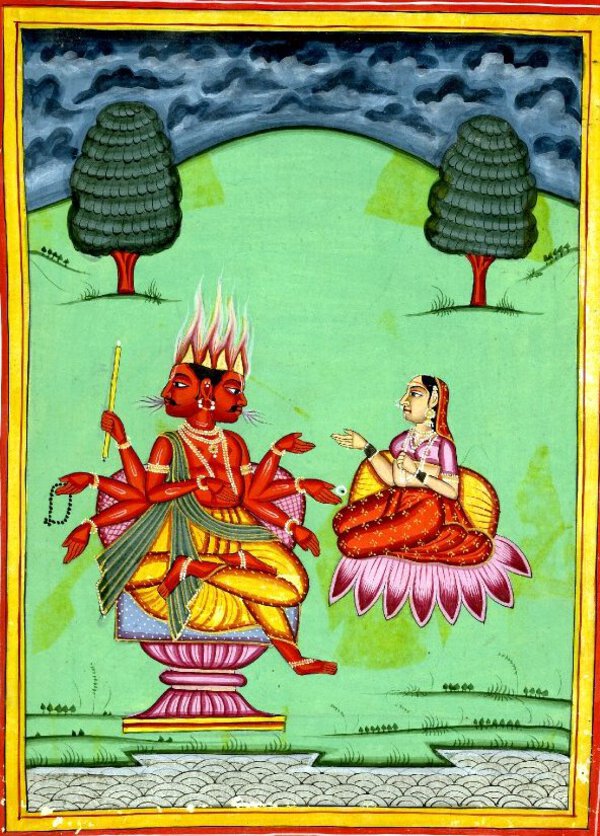
Another variant of the Kārtikeya story relates to the six bright stars of Kṛttikā. Agni was said to lust after the wives of the revered Saptaṛṣis. As he desired them, the goddess Svāhā desired him. In a brilliant ruse to save these wives from the seductive Agni and win him for herself, Svāhā disguised herself as each of six wives of the ṛṣis and fulfilled the unwitting Agni on six different nights. In so doing, she averted what could have been disastrous consequences arising from the seduction of the wives. In the end, the resourceful Svāhā won his love. Unfortunately, due to even the rumor of adultery, six of the seven wives of the ṛṣis were banished and took up residence as the six stars of the Pleiades. The seventh wife whose purity prevented her being impersonated remained with her husband as a faint star very close to the Saptaṛṣi constellation (Big Dipper).
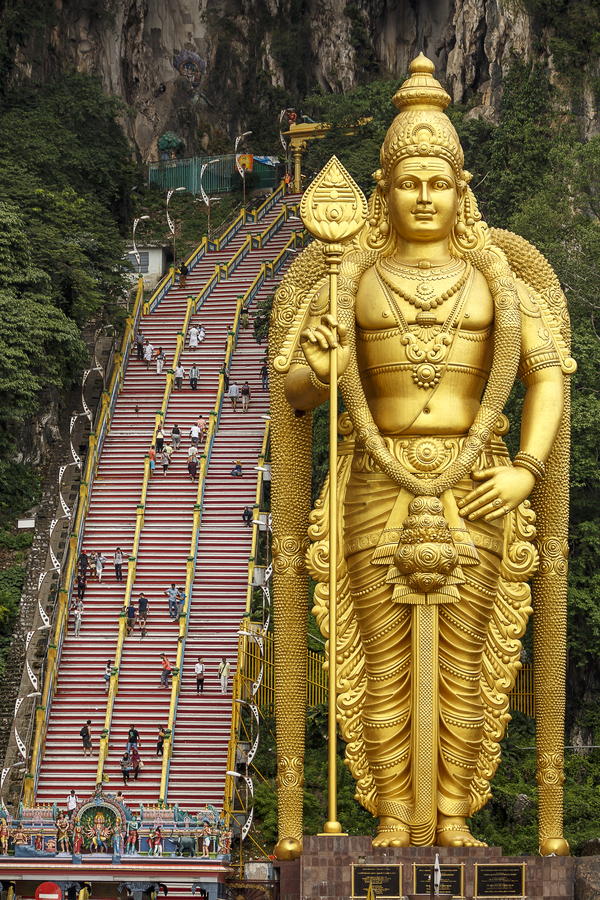
Though there are various accounts as to the exact parentage of Kartikeya, they have in common that the six wives adored the golden, charming child and adopted him. Therefore, themes such as nurturing, caring, and foster parenting can be present in Kṛttikā natives. Kartikeya had six heads, so as to be able to nurse from each one. This attribute of a huge appetite, along with Agni being personified as insatiable fire, leads to problems in this regard for the deity and for Kṛttikā natives. Agni lusted after not just one, but seven of the chaste wives. The saving grace in the story is that the fire god was able to redirect his passion with his consort, Svāhā.
Kṛttikā natives often have a great amount of passion. When it is channeled effectively, their brilliance and zeal can shine through artistic and innovative outlets; if it is not satiated in a healthy way, then the natives could be roiled in rumors, criticism, and iconoclasm. It is interesting to note that the wives of the Saptaṛṣis still had to suffer the consequences even though the scandal turned out to be a false accusation. This story can imply marital discord for a Kṛttikā native. It seems that no matter how extreme passion is resolved, it might be better if it were not there in the first place—there is always ash after something is burned away—or simply put, something’s gotta give.
The various versions of this story portray the creation of a powerful being, Kartikeya, as a direct result of Agni’s involvement, whether it was out of will toward accomplishing a goal or from overwrought lust. If Agni represents one’s heart, then Kartikeya is the fruit of that enacted desire. The lore seems to forewarn the masses not to underestimate the power of one’s intentions, as they can create unforeseen results. In the first version, the fire god is portrayed in the purest form: He had unwavering intention, audacity, and tremendous willpower as the bearer of the seed that would create a hero who destroyed a demon; in the latter story, the role of Agni is somewhat mixed—the role as a creator is maintained, but along with it came the truism that fire can go awry.
Don’t Play with Fire—Another Cautionary Tale
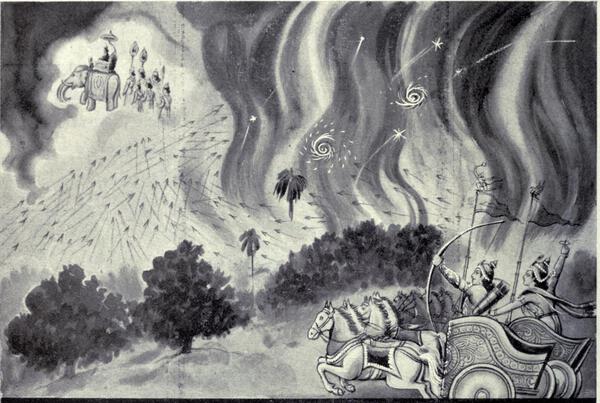
Though it is indisputable that fire has transformed human civilization by providing warmth, lighting, and enabling technological advances, equally undeniable is the fact that fire also destroys. In a more destructive tale, Agni was known to have burned down the entire Khāṇḍava forest, an ancient forest mentioned in the Mahābhārata, to help cure himself of dysentery due to continuous consumption of oblations. It was part of a tortuous plot with complex motivations involving other major deities such as Indra and Kṛṣṇa, but the upshot was the total destruction of untold animal and plant life.[2]
Sharpening the Kṛttikā Meanings

The Sanskrit word, Kṛttikā, is derived from two roots: kr- or krt-. The former means “to do” or “to make;” the latter means “to cut in pieces,” “destroy,” and “divide.” Doer-ship is a huge theme for this star. Kṛttikā natives can be creators, persons of action, inventors, scientists, or masterminds who attempt the impossible. The symbol (pratimā) of the nakṣatra invoked by the pattern of the six bright stars forming a razor or cleaver comports well with the cutting and dividing meaning of the krt root. It can be expressed as a sharp intellect on one hand, or cynicism and extremism on the other.
Like the deity, Agni, Kṛttikā natives have a knack for delivering messages—whether it is telling a story or working as go-betweens, such as brokers or agents. They also have the ability to purify, transform, and enable regrowth—themes that represent the sattvic nature of fire. Then, on the other side, there can be chaos and destruction, often accompanied by a whirlwind of uninhibited passion—be it lust, greed, pride, or fear. It can lead to mass upsets and disasters that shake the status quo. Such is the dual nature of fire. Kṛttikā natives are often taxed with complex, subjective motives that are often at war with each other. With such a wide spectrum of interpretations, how then, can one read the trajectory in a native’s chart?
Staring into the Fire
Much like how the ancients predicted events by looking up in the sky, many clues can be derived by understanding the patterns of the grahas (planets) in a Vedic chart. The “look” of the chart is akin to the appearance of a person—first impressions can tell a lot about a native, however, it can also lead to pitfalls. To decipher which way the fire tilts, one has to look beyond mere appearances. For instance, two seemingly utterly unrelated individuals, Matt Damon and Bernie Madoff, have quite a few similar chart features. Yet, the trajectory of events certainly has taken them to different places in life.
Burning Ambition
Matt Damon October 8, 1970, 15:20 Boston, MA, USA [3]
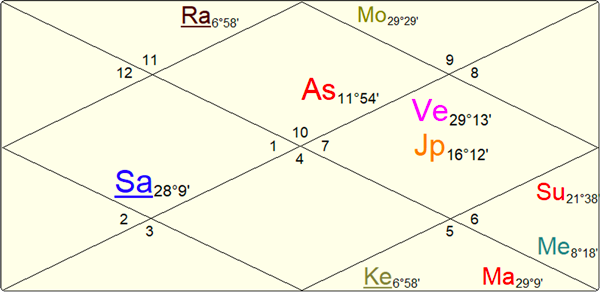
The Creator and Doer

Matt Damon is a an American actor and screenwriter who came to prominence in 1997 through the film, Good Will Hunting. Damon wrote and starred in the movie with his friend, Ben Affleck, and the work garnered them the Academy Award and Golden Globe for Best Screenplay. Parallel to how Agni brought Kartikeya into life, the character, Will Hunting, is a legacy of Damon’s creation. Damon, enlivened Will Hunting through both vivid acting and screen writing. This critically acclaimed film was praised to have “real wit and vigor” by The Daily Telegraph; Damon was able to stomach and digest the demanding role of Will and delivered a “realistic and credible” transformation of the character.[4]
Kṛttikā natives are ambitious and put tremendous effort toward attaining their goals. Damon has a large appetite for various roles and nothing is too daunting for him to carry. In the movie, Courage Under Fire, Damon appeared as an opiate-addicted solider. For this role, he lost 40 pounds in 100 days on a self-prescribed diet and fitness regimen.[5] In the film, The Martian, for which he won the Golden Globe Award for Best Actor, the doer and creator side of Kṛttikā is portrayed by Damon’s role as an astronaut. The story depicts an astronaut trying to survive on his own on Planet Mars—this, literally, is attempting the impossible.
The Case for the High Road of Agni
Damon is a Kṛttikā native, as his ruling lord, Saturn, sits at Aries 28°9”. From a quick glance at his chart, it can be seen that most of the grahas are centered around the very auspicious ninth and tenth bhāvas. The ninth bhāva represents dharma, actions that are in accord with natural law. The tenth is the bhāva of karma or all of our actions, which ultimately is the basis of our security in life through career, money, etc. It is therefore also known as an artha sthāna (representing resources in life).
In Damon’s chart, these two bhāvas are protected by the three natural benefics: Venus, Jupiter, and Mercury. They join in several combinations that indicate strong intelligence and discrimination, such as the Sarasvati Yoga and the Budhāditya Yoga. The powerful fifth lord of intelligence and tenth lord of career, Venus, itself makes a Mālavya Mahāpuruṣa Yoga. There are also Mahārāja Yogas that Venus forms with lagna lord, Saturn. These patterns indicate that the rightful means to secure material wealth is an important aim in his life.

Aside from his acting career, Damon is known for doing humanitarian work in Haiti, as well as founding charitable organizations, H2O Africa Foundation and Not on Our Watch Project.[6] He also serves as spokesperson for Feeding America and other causes that serve the underprivileged. These benevolent actions describe the nurturing and protective side of Kṛttikā natives and reflect the sattvic qualities of fire. In its purest form, fire protects humans from danger (wild animals) and sustains life. So, is Damon the personification of the sattvic light, or are there things lurking beneath the surface of the seemingly clean reputation?
Some may argue that Sun is considered to be a cruel planet and its occupation of the ninth bhāva as the eighth lord might spoil dharma. There were definitely difficulties with and for father. However the Sun itself is sattvic—the radiant cosmic provider of pure light and in a different context, we see it is the other member of the uspoiled Budhāditya Yoga, with the graha of intellect, exalted Mercury. This combination shows the sattvic use of intelligence, especially pertaining to following the laws of nature and higher order. This is especially notable with respect to his activism in the area of climate change, where his pointed criticisms of current policy are backed up by personally taking matters into his hands. This illustrates the constructive nature of Kṛttikā natives’ sharp wit and the ability to take righteous action.
Something’s Gotta Give
Another point of contention toward the seemingly spotless dharma and karma combination in Damon’s chart is none other than the placement of the native’s Ascendant lord, Saturn. Saturn is a natural malefic and its maleficence is much feared. Furthermore, it is doubly exaggerated: It is both retrograde and debilitated. It casts its malignant gaze on both tenth bhāva and lord, Venus, and the significator of dharma, Jupiter. As mentioned earlier, Kṛttikā natives can have a wide spectrum of temperament. Will the unstable, rogue, and amplified lagna lord make Damon a two-faced hypocrite?
A destiny pattern is a complicated tapestry where all is visible and yet some parts of the picture catch your attention and dominate the pattern. Saturn is a fascinating graha in this chart. Though both sides of Saturn’s glance will come forward in his life, it will be in the context of some strong mitigating factors. For starters, his Saturn is the lord of two positive bhāvas and is in a positive bhāva while only being aspected by natural benefics—Jupiter and a very strong Venus. There is also huge rise promised in his life through his many auspicious yogas, several centered on Saturn itself. Some Jyotiṣa texts address an unusual yoga that Damon’s Saturn meets exactly. Damon’s Saturn—retrograde and debilitated—is said to confer Rāja Yoga.[7] Also, the same Saturn is the graha whose retrogression strength further empowers the Rāja Yogas it makes with the svarāśi Venus. Venus, in turn, contributes to what is known as Nica Bhaṅga Rāja Yoga or modification of its debilitated state. As the lord of only positive bhāvas (first and second), Saturn will influence his career, his own Ascendant, and the sixth bhāva of service through, among other things, his charisma, his will, and his powerful speech.
It is not to say that Saturn’s maleficence disappears, but the tide set by yoga principles is in full force and a few contrary waves do not change that momentum. As a doer, much of Damon’s wealth, success, and fame, is amassed through relentless self-effort. However, the Saturn-Venus mutual aspect also forms a passion combination. A quick revisit to the myth reminds us that Agni had Svāhā as an outlet for his passion; in Damon’s case, he had Hollywood. Damon directed his passion toward artistic pursuits. The aforementioned yogas for intelligence and discrimination are also yogas that contribute to his creative gifts. These yogas have certainly accounted for his rise and success in the entertainment industry.
In the myth, the wives of Saptaṛṣis had to be separated from their husbands due to untrue rumors. Since the beginning of 2021, several online sites suggested that there was marital discord in Damon’s marriage. Whether it is true or not, it shows that something’s gotta give. The reality of being a well-known celebrity is that they will always be the subject of tabloid gossip. In another instance, Damon’s comment about a “spectrum of behavior” with regard to sexual misconduct drew much heated public criticism from the #MeToo movement. The influence of Mars and Rāhu adds flame and iconoclasm to the second bhāva of speech. The yogas involving Saturn brought Damon to great rise, but the afflictions caused by Saturn as the second lord were not nullified. Consequences always follow an action.
The Strange Case of Bernard L. Madoff and Ponzi Bernie
Bernie Madoff April 29, 1938, 13:50, New York, NY, USA[8]
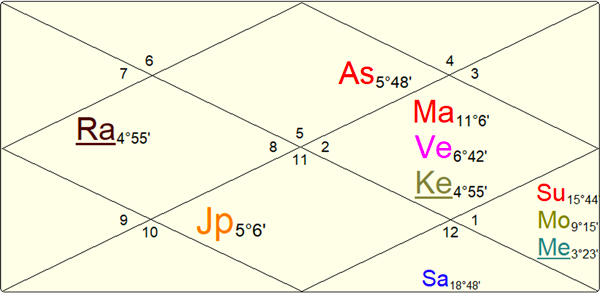
Four-Alarm Fire

Agni’s other face is that of a destroyer. What is fascinating is that sometimes this polarity can appear in charts with similar configurations, making it tricky to discern. It is especially true in white collar crimes. Like the allure of 0% interest, it is a great hook, but reality sets in when the prime rate rises. People are often convinced by the exciting large bold fonts and rarely read the fine print. The bull market is amazing until the next-door neighbor boasts euphorically about how they made money in the “slot market.” Where there is smoke, there is fire and where there is greed, there is corruption. Unfortunately, when the flame blazes through the roof, it is already too late. Such is the case of the 2008 housing market crash, and with its top blown off, came the reveal of the biggest financial fraud in history—the Strange Case of Bernard L. Madoff and Ponzi Bernie.
Enter Bernard L. Madoff
Mr. Madoff was an influential US American financier who had perpetrated a Ponzi scheme on an unprecedented scale—$64.8 billion over a span of more than a decade.[9] Prior to his arrest, Madoff was an “idolized” figure in the financial market and he was also a prominent philanthropist.

Madoff was the chairman of the NASDAQ stock market and his brokerage business was “wildly successful.”[10] He built an electronic trading platform using computer information technology. With this innovation, his firm was at one point the “largest market maker at the NASDAQ.” [11]Like the intermediary role of a fire deity, Madoff acted as an agent between businesses and investors, channeling funds to respective companies, which in turn granted attractive returns to their shareholders as a boon. Befitting the image of a high-profile financier, Madoff was described as “an affable, charismatic man who moved comfortably among power brokers on Wall Street and in Washington.” [12] The image of Mr. Madoff was that of a benevolent giver, trend maker, and innovative inventor—much like the creator side of Agni. Like a deity, he was worshipped, and people entrusted him with their life savings and retirement funds.
Their offerings, however, did not propitiate the idol, rather, it inflamed his greed. The fire god devoured an entire forest; Madoff incinerated much of his investors’ life savings. It is like a superhero story that has gone awry: Agni gave life and protection, but it also had capacity to destroy everything. This kind of character buildup is usually accompanied by complex, subjective motives which often clash with each other. On the one hand, Mr. Madoff was fervently protective of his family, and then he was the sole mastermind behind the fraud. He commented that his investors were “accomplices in some way, too.” The case of Madoff is fascinating because he is the superhero-turned-villain. Where in his chart does the clear sky before the storm show up?
A quick look at both Damon and Bernie’s charts shows some uncanny similarities. Both natives have tenth lord, Venus, placed in its own bhāva; both are blessed by the influence of multiple benefics, and these benefics are placed in trikonas and kendras. Unarguably, both natives rose to fame and are charismatic in their own ways. Like Damon, Madoff’s goals centered on dharma and artha. On the surface, Mr. Madoff was making a rightful living out of his business, and it was quite successful. It can be seen through a plethora of Rāja (pre-eminence) and Dhana (wealth) Yogas. Mars and Venus form a Mahārāja Yoga, Mars and Ketu form a Nodal Rāja Yoga-all in the tenth bhāva.[13]. His lagna lord, Sun, is exalted and makes two Dhana Yogas with Mercury. Both natives have Mālavya Yoga formed by Venus and Sarasvati Yoga formed by the great benefics, Jupiter, Venus, and Mercury. These combinations made Madoff a talented and smooth talker.
The Search for Ponzi Bernie


While both charts looked like clear blue skies, the air was certainly different. It is like the difference between an ordinary sunny day in California versus an eerily silent day on a Pacific island. As stated, in Damon’s chart, there is minimal affliction to the ninth and tenth bhāvas and lords, even considering Saturn and Sun. In contrast, in Madoff’s chart, all the natural malefics—Saturn, Mars, and the nodes—act on the tenth bhāva and its lord Venus without any relief from benefic influences. But the main show here is that Venus, the tenth lord of action, career, and reputation, is 6°42” of Taurus which is smack on the yoga tārā of Kṛttikā. Placement on the yoga tārā is like hitting the bullseye—the themes of that nakṣatra are more pronounced and become more pervasive in the native’s life. Sitting in the zenith of the chart, Venus ensures these themes will be on full display.
Ketu is close enough to the yoga tāra to give the added boost to the Kṛttikā influence. As a shadow graha, it mirrors other grahas. In Mr. Madoff’s chart, it acts two times like Venus: Venus is associated with Ketu, and it is its dispositor. In this chart, it is like having Venus and its doppelganger in the bhāva of actions! It certainly has much congruence in the native’s life—Mr. Madoff and his shadow, Ponzi Bernie, operated under the same roof. Furthermore, the native ran the time periods of Ketu and Venus from birth to his early 20s. Two decades, especially at an earlier stage of life, are enough to condition a native. If Kṛttikā were a country, then Madoff is a long-time resident who simply did not file for citizenship. Ironically, he got into trouble in the first place because he didn’t file with the SEC as a financial advisor.[14]
As good as Madoff’s yogas are, it is clear that they are under confluent, malefic influence. Such afflictions usually lead to a fall in career or a foul reputation for the native. In fact, Bernie burned down his entire career, family, and investors’ funds.

Even though the physical plant of his enterprises reflected an appearance of normality, what lay beneath was anything but. Madoff’s business occupied three floors of the Lipstick Building in New York City. He entrusted his two sons with legitimate market-making business on the 18th and 19th floor, while Ponzi Bernie ran an investment advisory division on floor 17. The partition of business is a literal representation of the dual face of Agni; metaphorically, they are the conflicting subjective motives of the native. Pride, greed, and deceit are like components of an explosive. When offered to Agni, the fire god ignites it.
A closer examination of the chart confirms the incendiary twist to the weather. There are a number of exaggerated grahas in Madoff’s chart. A graha is considered to be exaggerated when it is exalted, debilitated, combust, retrograde, new or full Moon, or in planetary war. A little exaggeration may be seen as “colorful,” but when five out of nine grahas are exaggerated and are mainly natural malefics, the nice warming fire begins to shoot out flames that might go out of control. In Madoff’s chart, Sun, Moon, Mercury, and the nodes are exaggerated. The condition of the former three are quite significant because they are placed in the ninth bhāva of dharma. Furthermore, they represent the higher mind, emotional mind, and the thinking mind, respectively. When all three faculties of mind are exaggerated, it can lead to self-aggrandizement and an “end justifies the means” attitude. These are some of the red flags whereby a person might swing to the other side.
To add more confluence, the downward drift, the shadowy nodes, Rāhu and Ketu, known to cause calamities, are exalted (Rāhu) and debilitated (Ketu), rendering them trickier and more powerful than usual.[15] Rāhu, when operating well, shows originality and ingenuity; in a troublesome state, it indicates illusion, deception, and trickery. Rāhu is also in a rare division called Pāśa drekkāna, meaning a noose, suggesting ensnarement and trapping. It is also in the more widely known Sarpa drekkāna. Sarpa means “a serpent,” and like a snake, it invokes slithering, being slippery and cunning. Madoff had slipped out of prior investigations in the early 1990s and it wasn’t until almost two decades later, in 2009, that he was arrested for fraud.
The Balance Sheet
Damon used his brilliance and fiery will in screenplays and acting; Bernie, on the other hand, fed it to the greed of the fire. In comparing the destiny patterns, the apparent similarity is undermined by the degree of affliction and exaggeration to key indicators in Madoff’s chart. The afflictions play into the intensity of the passion combinations, a main theme for Kṛttikā natives. As with everything, moderation is key. Damon had one passion combination formed by Saturn and Venus. The composite pair is undisturbed by malefic influences. Given the rest of chart configurations, it gave him a healthy dose of ambition and zeal toward his work. In comparison, there are triple sets of passion combinations in Madoff’s chart, each with its own extra dose of Red Bull®. Agni lusted after all seven wives of the ṛṣis. Damon had Hollywood as his Svāhā, but Bernie was insatiable. His fire was more uncontrollable in that the very grahas that make the passion combinations—Mars, Venus, Rāhu, Ketu, and Saturn—further fan one another’s flames. In a chart already loaded with exaggeration and afflictions, he burned down the forest. In a New York Times article, Madoff was described as “a charlatan of epic proportions, a greedy manipulator.” Fire is indiscriminate. When kāma (desire) goes out of control, self-incineration often follows.
The Moral of the Story
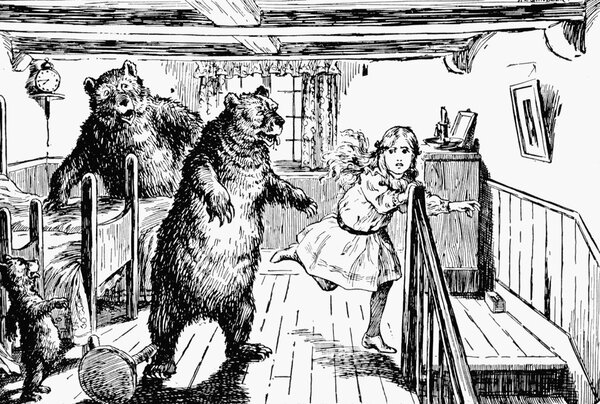
The narrative of Damon is the story of hope, of rising from a humble origin to the pinnacle of success; Madoff’s is that of destruction, of how unattenuated greed burned down everything. The stories illuminate the two faces of Agni, both as a creator and a destroyer. One’s success is celebrated, and the other’s fall castigated, but rarely do people question the true face of this duality.
Agni is the grand master of rituals. Without its devotees, however, it would not have come to life. In the same vein, a great show cannot exist without a witty host or in the absence of viewers. It seems that we are always looking for ways to attribute a part of ourselves onto another being: be it tangible or intangible. Like the devotees of Agni, it is the collective public that has enabled the stars that we see today. Similarly, would Madoff’s crime have ballooned to the scale it did had there not been collective greed and complacency? In a world with so much complexity and alternative facts, time-honored myths and bedtime stories offer simple, accessible wisdom. There is a lot to learn from Goldilocks—be critical and always examine before you pick what is just right.
Author: Serene Piao

Serene Piao is a 500-hr yoga practitioner and a student of Vedic astrology. She attended various astrology workshops since 2014 in search of a Jyotish teacher. In November 2017, she joined Penny Farrow’s astrology camp at Arsha Vidya Gurukulam in Saylorsburg, PA, and has been her student ever since. Serene works as a primary school teacher. Her mission is to live a more conscious life and prepare her students to develop as whole individuals. In her spare time, she enjoys doing dream analysis, tarot, and giving astrology readings.
Endnotes:
[1] Farrow, Penny. 2021. “Diamonds of Destiny: The Nakṣatra Yoga Tārās.” The Cosmic Kaleidoscope Journal. Vol. 2 June 1, 2021. Accessed June 16, 2021. https://vedicchart.com/cosmic-kaleidoscope-journal/diamonds-of-destiny-the-naksatra-yoga-taras/
[2] Wikimedia Foundation. n.d. Khandava Forest. Accessed May 2021. https://en.wikipedia.org/wiki/Khandava_Forest.
[3] n.d. "Astrodatabank." astro.com. Accessed April 21, 2021. https://www.astro.com/adb-search.
[4] Wikimedia Foundation. n.d. Matt Damon. Accessed May 2021. https://en.wikipedia.org/wiki/Matt_Damon.
[5] Ibid
[6] Not On Our Watch is an international relief and humanitarian aid organization that seeks to end human rights violations in Darfur and beyond. Source note: Wikimedia Foundation. n.d. Not on Our Watch (organization). Accessed May 2021. https://en.wikipedia.org/wiki/Not_on_Our_Watch_(organization).
[7] Sharma, Nikhil. Farrow, P., ed. 2020. "Exploring the Enigma of a Retrograde Graha through the Lens of Śāstra." The Cosmic Kaleidoscope (https://vedicchart.com/cosmic-kaleidoscope-journal/exploring-the-enigma-of-a-retrograde-graha-through-the-lens-of-sastra/) 1. Accessed May 2021.
[8] n.d. "astrodatabank." astro.com. Accessed April 21, 2021. https://www.astro.com/adb-search.
[9] Wikimedia Foundation. n.d. Bernie Madoff. Accessed May 2021. https://en.wikipedia.org/wiki/Bernie_Madoff.
[10] corporatefinanceinstitute.com. n.d. Bernie Madoff. Accessed May 2021. https://corporatefinanceinstitute.com/resources/knowledge/other/bernie-madoff/.
[11] Wikimedia Foundation. n.d. Bernie Madoff. Accessed May 2021. https://en.wikipedia.org/wiki/Bernie_Madoff.
[12] Julie Creswell and Landon Thomas, Jr. 2009. "The Talented Mr. Madoff." The New York Times, January 24: https://www.nytimes.com/2009/01/25/business/25bernie.html?smid=url-share. Accessed May 2021.
[13] A nodal Rāja Yoga is when either node is in a kendra with a trikona lord or a trikona with a kendra lord. Some traditions leave out the lord of the seventh and the seventh bhāva for creating this yoga.
[14] The analogy is intended to draw a parallel to the real-life event: Madoff got into trouble in the first place because he did not file to SEC as an investment adviser for the funds that he managed. It is a breach of the Investment Advisers Act.
[15] There are different views on where Rāhu and Ketu are exalted and debilitated. The viewpoint used in this article is that they both exalt in Scorpio and both debilitate in Taurus.
Works Cited:
n.d. "Astrodatabank." astro.com. Accessed April 21, 2021. https://www.astro.com/adb-search.
corporatefinanceinstitute.com. n.d. Bernie Madoff. Accessed May 2021. https://corporatefinanceinstitute.com/resources/knowledge/other/bernie-madoff/.
de Fouw, Hart and Robert Svoboda. 1996. Light on Life. Twin Lakes, WI: Lotus press.
Dr. G.S. Kapoor, translation/commentary/annotation. 2020. Phaladīpikā. New Delhi: Ranjan Publications.
Julie Creswell and Landon Thomas, Jr. 2009. "The Talented Mr. Madoff." The New York Times, January 24: https://www.nytimes.com/2009/01/25/business/25bernie.html?smid=url-share.
R. Santhhanam, translator/commentary/editing. 2018. Bṛhat Pārāśara Horā Śāstra . New Delhi: Ranjan Publications .
Sharma, Nikhil. 2020. "Exploring the Enigma of a Retrograde Graha through the Lens of Śāstra." The Cosmic Kaleidoscope (https://vedicchart.com/cosmic-kaleidoscope-journal/exploring-the-enigma-of-a-retrograde-graha-through-the-lens-of-sastra/) 1.
Wikimedia Foundation. n.d. Bernie Madoff. Accessed May 2021. https://en.wikipedia.org/wiki/Bernie_Madoff.
—. n.d. Khandava Forest. Accessed May 2021. https://en.wikipedia.org/wiki/Khandava_Forest.
—. n.d. Matt Damon. Accessed May 2021. https://en.wikipedia.org/wiki/Matt_Damon.
—. n.d. Not on Our Watch (organization). Accessed May 2021. https://en.wikipedia.org/wiki/Not_on_Our_Watch_(organization).













